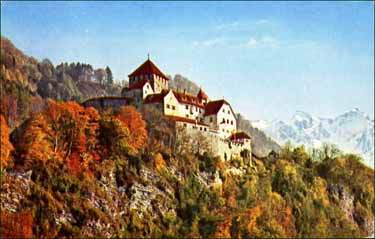
Figure 1 - common front
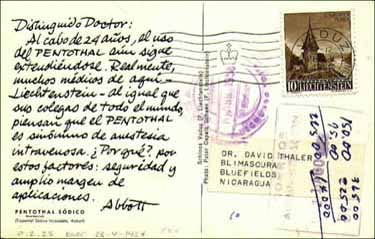 Figure 1a |
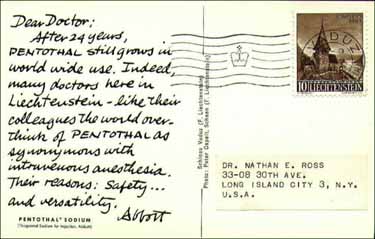 Figure 1b |
A Postmark Collector's Delight
By Henry Ratz razor1@volcano.net
published in the October 2002 issue of Liechtenstudy
One of my favored item among my machine cancel collection was mailed from Liechtenstein. Going back some 75 years, Liechtenstein was home of some very clever Direct Mail Marketing people, who over the years managed to accumulate an impressive array of demographic address lists from around the world. We know from many undeliverable and returned mail pieces that for some mailings they used a wide-angle shotgun approach, but some other lists were of pin-point accuracy. The most common mailings were done for a lottery and a gift shoppers club.
Around 1956-58, and then again in 1967, the American pharmaceutical behemoth Abbott Laboratories used their services to peddle their intravenous anesthesia agent PENTOTHAL to doctors around the world. Although I show you here only the two that were mailed from Liechtenstein, they actually created a whole set of postcards with a simulated handwritten text to make them appear as personal a message as such mass mailings would allow and then mailed them from various countries, with local views on the reverse side.

 Figure 1a |
 Figure 1b |
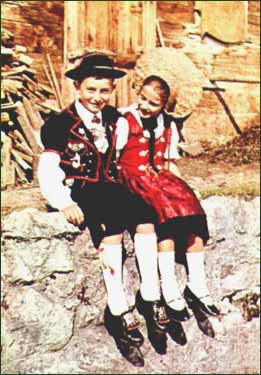 Figure 2 (front) |
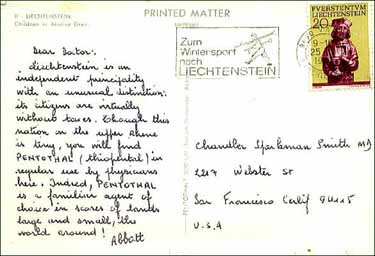 Figure 2 (reverse) |
The Liechtenstein mailings were first done on June 3, 1956, followed by another mailing on May 28, 1958, see Fig. 1a-1b, front and back. A third I found was mailed on May 25, 1967, see Fig. 2, front and back, but it is quite possible that other dates and other cards exist, they just haven't shown up in bourse boxes around Northern California yet. Fig. 1a shows the only card I have found so far in a language other than English. That obviously leaves open the question as to how many foreign languages they used to pitch their product in addition to this Spanish one sent to a physician in Nicaragua. The card is doubly interesting in as much as it shows two oversized (typical for Latin American countries) arrival cancels. The round one is from MANAGUA, dated August 6, 1958 and the rectangular one is from BLUEFIELDS, dated August 11, 1958. So, the whole journey, paid for with a 10 Rp. stamp for the international surface Printed Matter rate in effect at that time, took exactly 75 days. Somehow - and here I am strictly guessing - it was sufficient to stimulate the interest of the addressee The figures written on the card would indicate that he called a rep or someone and nailed the prices and maybe profits for that product down.
As one can observe, the earlier mailings used pre-typed address labels, but in the later mailing they made it look like the whole card was written by hand. A closer look reveals that the text was actually printed in offset and the address was printed from a small plate in letterpress with minimum pressure. Pretty clever stuff.
For those of you interested in machine cancels, here are the stats for the ones shown here:
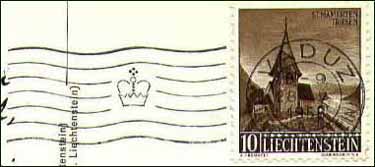 "A Crown" cancel |
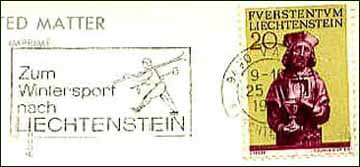 "D Crown" cancel |
Fig. 1a-b was cancelled with a so-called A crown from Vaduz, that was first introduced November 15, 1925. We find it as a stand-alone, i.e. without flag, on many of the mass mailings from Liechtenstein. Specifically, it is termed a "Loan" crown, meaning that it belonged to the post office of Vaduz but was used at the nearest post office that was equipped with a high-speed automatic canceller, in this case the post office at St. Gallen in Switzerland. Around September 1955, earliest known date thus far is September 24, 1955, a new flag specifically designed for Liechtenstein mail was added. It's made up of 7 wavy lines, the top and bottom ones a bit heavier than the rest and a Princely crown placed slightly to the right of center. It is 44 mm wide and was cataloged by the Swiss Cancel Society under the number 0.2.23.
Fig. 2 was cancelled with the so-called D crown of Vaduz, first introduced on January 31, 1966. By then, the Vaduz post office was equipped with high-speed machinery. The flag is number 3.62, from the category of town (or specific region) promotion subjects.
For those of you curious about PENTOTHAL, here is a brief description from the Internet:
Pentothal / Anesthesia
Patent Number(s) 2,153,729
Ernest H. Volwiler and Donalee L. Tabern discovered the general anesthetic Pentothal, one of the most important agents in modern medicine. Volwiler and Tabern discovered Pentothal in 1936 when they were seeking a substance which could be injected directly into the blood stream to produce unconsciousness. For three years the two men screened over 200 compounds, eventually arriving at a sulfur-bearing analogue of Nembutal. Induction was smooth, pleasant, free of muscle twitching, and notably lacking in delirium or frightening psychic effects. It could be used for minor procedures requiring anesthesia or for more prolonged procedures, being administered before ether.As a result of his efforts, Abbott in 1948 became the first pharmaceutical company to supply radio pharmaceuticals to medical and research institutions. The uses of Pentothal are legend. Few agents in medicine have played such an outstanding role in improving the well-being of generations of patients.